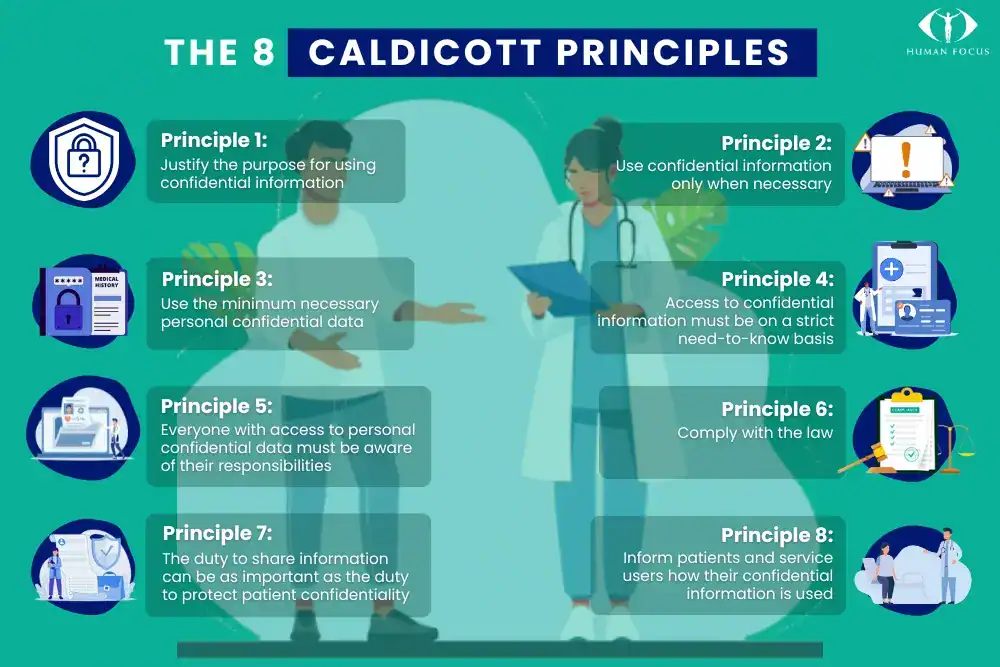
The Caldicott Principles are a set of eight guidelines that shape how health and social care organisations manage confidential patient information.
First created in 1997, they were designed to stop private data being shared too freely within the NHS and to build public trust in how sensitive information is handled.
Since then, the principles have been updated twice, in 2013 and 2020, and remain the foundation for safe and lawful data sharing in healthcare.
This guide explains the eight Caldicott Principles, why they matter, and how they support both patient privacy and effective care.
Key Takeaways
- The Caldicott Principles were created in 1997 to guide the NHS and other health services on how to handle patient information safely and responsibly.
- The principles highlight that confidential data should only be used when absolutely necessary, that access should be restricted to those who genuinely need it, and that staff must fully understand their duty to protect privacy.
- Every health or social care organisation is expected to have a a senior professional (Caldicott Guardian) who makes sure information is handled legally, ethically, and in line with best practice.
- Applying the principles also helps organisations comply with broader laws such as the UK GDPR and reduces the risk of data breaches that could harm both patients and providers.
What Are the Caldicott Principles?
The Caldicott Principles provide a framework to help health organisations ensure proper handling of confidential information. Following the principles helps organisations make correct decisions when processing this information and works to protect patient confidentiality in a variety of situations.
Organisations and those working within them must be able to determine when sharing confidential patient information could breach data protection laws.
When potential conflicts or difficult decisions arise, the Caldicott Principles can aid with decision-making. The principles also cover secure transfer methods of sensitive patient information to other agencies such as the police, social services, the education system and the judicial system.
Where Did the Principles Come From?
The Caldicott Principles were developed after a review of NHS patient data handling. At the time, the rise of technology and data collection caused concern that confidential information could be too easily shared and that privacy could be too easily breached.
Chaired by Dame Fiona Caldicott, the review led to the identification of best practices concerning data security. Current guidance on the processing of health and adult social care data comes from the National Data Guardian. The original six principles set out in 1997 have been expanded twice (in 2013 and 2020), and now the list includes eight Caldicott Principles.
The 8 Caldicott Principles Explained
The Caldicott Principles are built on the idea that patients should have as much control as possible over their personal information and that patients should be assured that the information held by health and social care organisations is safe from unnecessary disclosure. Patients should also have complete confidence in the systems that hold this information.
There are eight principles for healthcare professionals to properly handle patient information.
Principle 1: Justify the Purpose for Using Confidential Information
Each time confidential information is used or transferred, the purpose of doing so must be clearly defined, examined and documented. An appointed Caldicott Guardian should review each action, use or transfer to ensure that patient privacy is protected as much as possible. If the same patient information is being shared multiple times, the Guardian must examine each instance for propriety.
Principle 2: Use Confidential Information Only When Necessary
Confidential information should be limited to purposes that require it. In other words, confidential information should be left out whenever possible. If a specified purpose requires the use or sharing of confidential information, it must be carefully limited to the scope of the purpose. The need to identify individuals should be weighed at each step of the process, and alternatives should be used whenever possible.
Principle 3: Use the Minimum Necessary Personal Confidential Data
When the use of confidential information is unavoidable, the amount of information used should be kept to an absolute minimum. Only the information pertaining to a task should be made available. Tasks and purposes requiring confidential information should be completed with minimal intrusion into personal matters or information.
Principle 4: Access to Confidential Information Must Be on a Strict Need-to-Know Basis
Only people who truly need it should be given access to confidential information and access should be limited to the items they need to see. Access controls or split information flows are helpful for this.
Principle 5: Everyone with Access to Personal Confidential Data Must Be Aware of Their Responsibilities
Personnel who work with, handle, organise, receive or transmit confidential data must fully understand their duty to protect patient and service user confidentiality. These employees should be given special training, and additional reminders should be built into the systems they use.
Principle 6: Comply with the Law
Each and every use of confidential information must be lawful. Each person handling such information is personally responsible for ensuring that the legal integrity of data sharing and storage remains secure.
Principle 7: The Duty to Share Information Can Be as Important as the Duty to Protect Patient Confidentiality
If a health or social care worker finds that sharing information is in the best interest of the patient, they should be able to do so with confidence, provided that they follow the other principles. These decisions to share should be supported by their employer, regulator, and professional bodies or associations.
Circumstances in which sharing may meet such criteria include:
- Patients are transferred from one hospital to another for further treatment
- Patients, or others they’re connected to, may be at risk of harm
- Patients pose a risk to themselves or others
- A crime may be prevented by sharing the information
- A patient has died, and their relatives need to be identified
- Information has been requested by a legal authority or court order
Principle 8: Inform Patients and Service Users How Their Confidential Information is Used
Patients and service users should have clear expectations about how and why their confidential information is shared and what choices are available to them when it happens. Organisations should follow proper procedures closely when handling confidential information. At a minimum, organisations should provide patients with accessible, relevant, and appropriate information about the process. Some patients may need to participate more in the process, depending on the case.

What Is Confidential Information?
All data that a person would expect to it will be kept private is confidential information. This includes data collected for health and social care that can be linked to a patient’s identity, such as their:
- Full name
- Home address and postcode
- Date of birth
- NHS number
- Test results
- Symptoms, diagnosis and treatment
The Caldicott Principles apply to all such information.
What Is a Caldicott Guardian?
Caldicott Guardians a senior people responsible for protecting confidential information in health or social care organisations. They must ensure that patient information is used ethically, legally, and appropriately.
A Caldicott Guardian must also manage confidential information in accordance with UK legislation, such as UK GDPR.
Caldicott Guardian duties are detailed in the Caldicott Guardian guidance for organisations. Resources and support for Caldicott Guardian is available at the UK Caldicott Guardian Council (UKCGC) website.
Should You Appoint a Caldicott Guardian?
Initially, Caldicott Guardians were needed in NHS organisations and local authorities that provide social services. However, the current guidance widens the type and number of organisations that are expected to have a Caldicott Guardian. Organisations that should have a Caldicott Guardian now also include:
- Public bodies involved in health services, adult social care, or adult carer support in England.
- Other organisations that provide similar services under public contracts and process confidential information about service users.
These organisations are also expected to register the details of their Caldicott Guardians on the Caldicott Guardian Register.
Note: The guidance does not prevent other organisations from appointing Caldicott Guardians.
An appointed Caldicott Guardian should be:
- On the management board or a member of the senior management team.
- A senior health or social care professional.
- Responsible for promoting clinical governance within the organisation.
How Can You Apply the Caldicott Principles?
The Caldicott Principles must be followed by health and social care organisations. They provide guidance on how best to ensure that patient data is kept confidential and can also prevent damaging data breaches.
When applying the principles, the first thing to do is to ensure that everyone involved understands that the Caldicott Principles exist to protect patients. While the principles heavily emphasise caution and restraint when handling patient data, it’s equally important to remember that sharing data is sometimes more beneficial to the patient than withholding it (principle number seven).
Organisations and staff should regularly review their policies and procedures, keeping in mind the Caldicott Principles. Correct use of the principles should maximise patient privacy while also promoting patient care.
Conclusion
The Caldicott Principles play a vital role in health and social care by safeguarding patient information. When applied correctly, they help prevent data breaches, protecting both individuals and organisations.
Understanding data protection laws, including GDPR, is just as important. GDPR sets the legal framework for handling personal data across all industries, ensuring compliance and reducing the risk of fines or reputational damage.
To strengthen your knowledge and compliance with data protection regulations, consider taking our online GDPR course. It provides a clear understanding of GDPR principles, legal requirements, and best practices for managing sensitive data securely. Whether you work in healthcare, business, or any other sector handling personal information, this course will help you stay compliant and protect the data you manage.






















